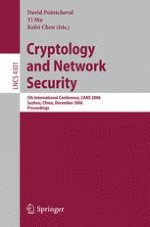2006 | Book
Cryptology and Network Security
5th International Conference, CANS 2006, Suzhou, China, December 8-10, 2006. Proceedings
Editors: David Pointcheval, Yi Mu, Kefei Chen
Publisher: Springer Berlin Heidelberg
Book Series : Lecture Notes in Computer Science
